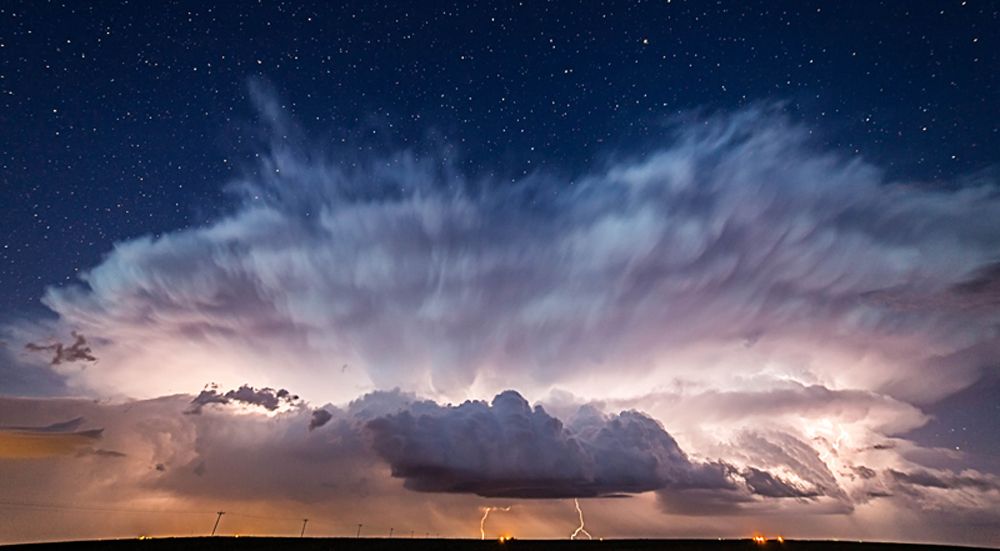Surreal Storm Rages Against Starry Backdrop in Winning Weather Photo

One stormy evening in July, photographer Brad Goddard looked in his rearview mirror and noticed an ominous storm building behind him. He pulled over and watched as a funnel cloud dipped below the clouds. And then he snapped a once-in-a-lifetime image of the tornado roaring across the road.
That image was one of three that netted Goddard, an engineer and professional photographer in Orion, Illinois, a prize in the first-ever Weather in Focus photo contest by the National Oceanic and Atmospheric Administration (NOAA). Other winners included stunning shots of tempestuous storms, as well as everyday weather like rippled clouds over the Smoky Mountains and drops of rain dotting a fallen leaf.
Judges narrowed down more than 2,000 entries to three winners and one honorable mention in each of four categories: Science in Action; Weather, Water & Climate; Professional Submissions; and In the iMoment, a category for photos taken with phone cameras and mobile devices. [See the Winning Weather Contest Photos]
"What I was looking for was that emotional connection," said Douglas Hilderbrand, a contest judge and meteorologist with the National Weather Service.
Photogenic storms
Goddard took first, second and third place in the professional category with his dramatic images of extreme weather. The winning photograph, taken in May 2014, shows a storm juxtaposed over a starry sky just south of Julesburg, Colorado. Goddard had been chasing the storm for three or four hours before he snapped the photograph, he told Live Science.
"As it pulled away, it was still putting out a bunch of lightning, but it was the only cloud around, so I got the really amazing starry sky off to the east above the storm," he said.
Sign up for the Live Science daily newsletter now
Get the world’s most fascinating discoveries delivered straight to your inbox.
Second and third place were photographs of two tornadoes spawned in a storm on July 6, 2014. Goddard first captured the photograph of the tornado crossing the road near Reinbeck, Iowa. Later that evening, as the sun went down, he took a photo of a second tornado near Traer, Iowa. The sun behind Goddard lit the funnel cloud in orange.
The judges of the contest were not given the photographers' names when voting on entries, Hilderbrand said, and weren't aware that all three winning professional images were Goddard's.
"At the end of the day, his photos were really miraculous," Hilderbrand said.
The photos, viewable on Goddard's website, are also the result of a lot of hard work. Goddard drives about 15,000 miles (more than 24,000 kilometers) a year chasing storms to photograph, he said.
The runner-up in the category was less flashy but no less beautiful. A black-and-white shot of fog rolling in by a pier, the picture was taken in Belmar, New Jersey, by photographer Robert Raia.
Diverse weather
The winner of the Weather, Water & Climate category is a frozen-in-time shot of a train barreling through a snowstorm. It was Hilderbrand's personal favorite.
"I told the other judges when we went over these, 'That's the kind of picture I would put in my living room,'" he said.
Other winners in the category include a nighttime scene of the aurora over Lake Superior, a stunning panorama of a downpour in the desert and a leaf studded with jewels of rain. The Science in Action category highlights research equipment such as West Virginia's Green Bank Telescope standing out against a starry sky.
Fancy cameras were not a prerequisite for the category In the iMoment, featuring snapshots taken with smartphones. The winner, "Smoky Mountains" by Elijah Burris, shows rippled clouds over the mountains in Canton, North Carolina. These types of clouds are called gravity waves, Hilderbrand said. Second place in the category went to a spring bud encased in ice, and third place to fiery orange clouds over a weathered white fence in Lake Tahoe, California.
Hilderbrand said the goal of the contest is to get people to focus on the weather and the science of meteorology in a way that stands out amid information overload.
"We are looking at ways to rise above the noise," he said.
Follow Stephanie Pappas on Twitter and Google+. Follow us @livescience, Facebook & Google+. Original article on Live Science.

Stephanie Pappas is a contributing writer for Live Science, covering topics ranging from geoscience to archaeology to the human brain and behavior. She was previously a senior writer for Live Science but is now a freelancer based in Denver, Colorado, and regularly contributes to Scientific American and The Monitor, the monthly magazine of the American Psychological Association. Stephanie received a bachelor's degree in psychology from the University of South Carolina and a graduate certificate in science communication from the University of California, Santa Cruz.












